The Killing Fields
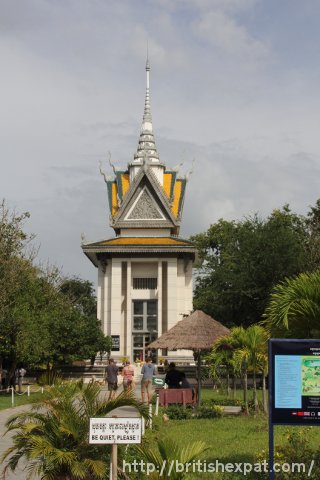 We’ve all heard of Cambodia’s Killing Fields. How many of you have heard of the Choeung Ek Genocidal Center? That’s the official name for this place, which has become a major tourist attraction near Phnom Penh in Cambodia.
We’ve all heard of Cambodia’s Killing Fields. How many of you have heard of the Choeung Ek Genocidal Center? That’s the official name for this place, which has become a major tourist attraction near Phnom Penh in Cambodia.
Fewer than four decades ago, in the late 1970s, these fields were the site of an extermination camp in a campaign of genocide by Pol Pot and his Khmer Rouge regime. About 20,000 people were tortured and murdered here.
There are approximately 300 killing fields in Cambodia, and Choeung Ek is the most well known. It’s estimated that 1.7 million people (about 21%) of the Cambodian population were murdered in the killing fields around the country.
The crimes of those who were put to death? Being educated. Suspected of being supportive of the former government. Belonging to modern society rather than the illiterate peasant class. Wearing spectacles. The victims were loaded into trucks and taken here to be eliminated so that Cambodian society could go back to Year Zero and Pol Pot’s communistic vision of an idyllic peasant lifestyle. More people arrived than could be killed in any one day, so they were imprisoned and tortured until it was their turn to be murdered.
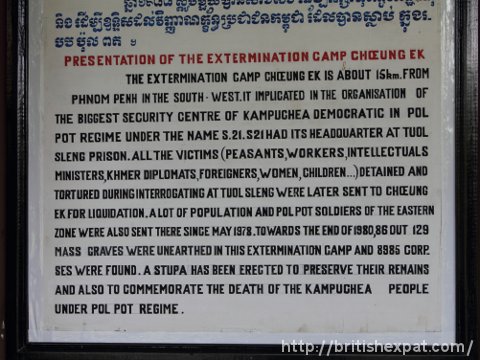
The would-be visitor has mixed feelings. A kind of horrified fascination. How can such a place be a big tourist attraction? I don’t like the idea of going to gawk at the aftermath of such horrors. I feel uneasy about being a rubber-necked tourist at a place of so many brutal deaths. I’ve heard that it’s not a place for the squeamish or the faint-hearted.
But I go anyway, I suppose just to see what it’s like, and because I have a sense it’s necessary to go to better understand what really happened.
We hired a moto (a passenger carriage towed by a scooter) to take us there. Our driver, Peter, knew the way (it’s clearly signposted anyway) and thoughtfully stopped off en route to buy us cloth face masks to cover our noses and mouths. We wondered why at first, but after experiencing the onslaught of dust on the road churned up by the lorries and other traffic on the road, we quickly got the idea and donned the masks. The journey took almost an hour. Of course we could have got there faster, but we weren’t in any hurry. (It’s only about 15 km from the city centre.)

On arrival at Choeung Ek, we each paid our $3 entry fee and an additional $2 for the hire of the audio tour equipment. I had asked Jim at the California 2 if we should hire a guide and he’d advised that the audio tour would be fine. As it turned out, the audio tour was excellent, very informative and professionally presented, and we saw some people with guides who simply told them a sentence or two before moving on to the next stop. If you go, then definitely hire the audio player. You can stop, start, pause, replay, and do as you wish with it.
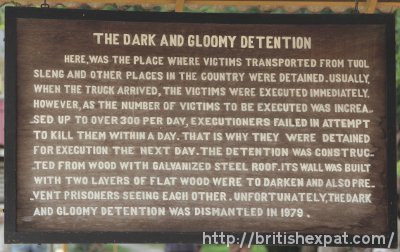
We were given a leaflet with a map of the area and an audio tour “stop list”. This enabled us to walk around the site in a logical progression and listen to the history of each location we visited. It was a beautiful sunny day and the place was so peaceful, yet as the details unfolded one could feel the “ghosts” of the people who had once passed through this extermination camp. I don’t really mean ghosts, it was just that the place had an atmosphere – a presence.
Most of what was there has now gone, except for the mass graves, some of which have been exhumed. The buildings were demolished and plundered by people full of fear and hatred after they discovered the true nature of the place. Now there are signs in Khmer and English where the buildings once stood. This was the chemical storage room. Here is where they stored the weapons – or the killing tools, as they chillingly describe them.
Chemicals were used both to disguise the smell of decomposing bodies and to kill off those who had been inadvertently buried alive.
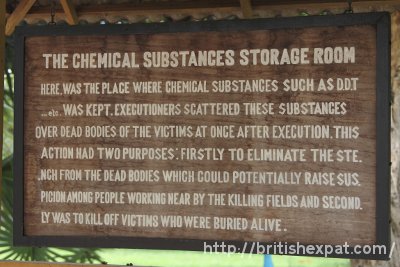
People were usually bludgeoned to death. Bullets were expensive so it was much cheaper to use axes, knives, and even bamboo sticks to kill them.
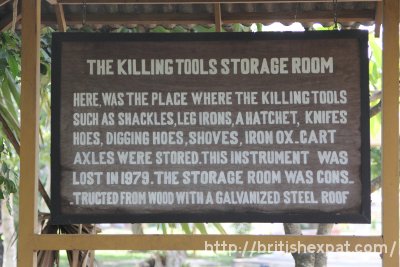
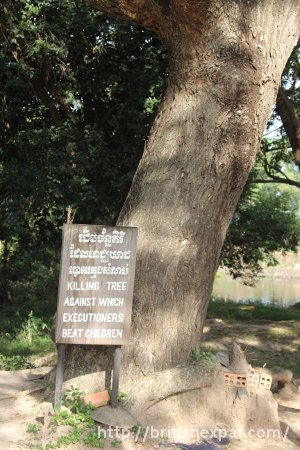 Children were easier to deal with. They were simply battered to death by swinging them against a tree. I wondered why they would kill and torture children. I thought perhaps they were used to force their parents to “confess” or something. Apparently they were killed so they wouldn’t grow up hating the Khmer Rouge for what they had done to their parents and possibly seeking revenge.
Children were easier to deal with. They were simply battered to death by swinging them against a tree. I wondered why they would kill and torture children. I thought perhaps they were used to force their parents to “confess” or something. Apparently they were killed so they wouldn’t grow up hating the Khmer Rouge for what they had done to their parents and possibly seeking revenge.
There is a big old beautiful tree there which was regularly used for this purpose. It’s now called the Killing Tree.
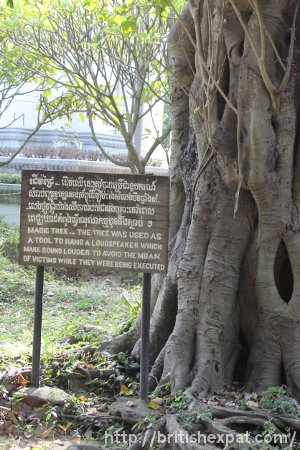 Another tree nearby has been named the Magic Tree. There isn’t anything magical about it. It was used to hang loudspeakers on, blasting out Khmer Rouge songs so that anyone nearby might think it was just a party meeting going on. The songs drowned out the screams of those being tortured and murdered. The audio guide informed us that a diesel generator would have been running to provide the electricity for the loudspeakers, and that the blaring propaganda songs and the constant chugging of the generator would have been the last sounds the victims heard as they were being hacked and bludgeoned to death.
Another tree nearby has been named the Magic Tree. There isn’t anything magical about it. It was used to hang loudspeakers on, blasting out Khmer Rouge songs so that anyone nearby might think it was just a party meeting going on. The songs drowned out the screams of those being tortured and murdered. The audio guide informed us that a diesel generator would have been running to provide the electricity for the loudspeakers, and that the blaring propaganda songs and the constant chugging of the generator would have been the last sounds the victims heard as they were being hacked and bludgeoned to death.
Many of the graves have been exhumed and some still remain as they were. Sometimes after heavy rain, bits of clothing, teeth or bones rise to the surface. These are collected by the site officials. You can wander around at your own pace and see all the sunken areas which were previously mass graves.
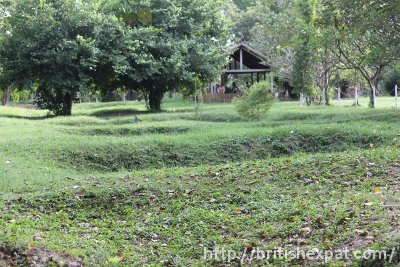

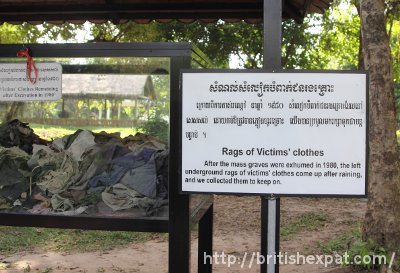
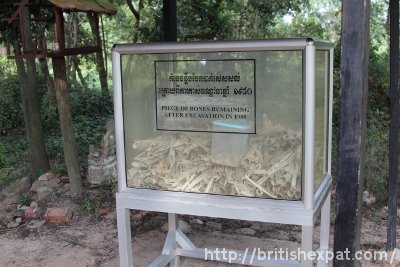
There is also a small museum on-site. There is no additional charge to go in and have a look around. I had a quick look but the some of the exhibits were so awful, I couldn’t stand it for very long. It’s not that I’m squeamish. But it’s hard not to cry when you see the results and tools of such brutality – bashed-in skulls, weapons that were used, etc.
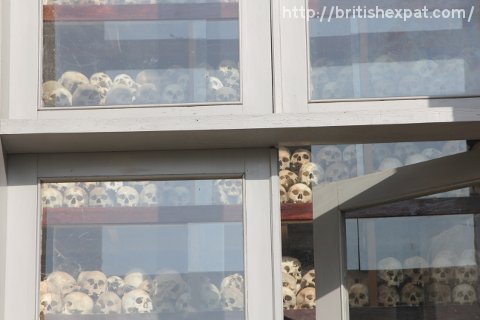
The centrepiece, and the first and last thing you see, is the memorial stupa. There are about 8,000 skulls in there, recovered from the exhumed graves. They hold a memorial service every year to remember and pay respect to the dead. It’s a beautiful yet macabre monument. I declined to go inside and gawp at the skulls. I’d already got the message of what had gone on here.
Postscript
Coincidentally, just after we’d left Phnom Penh the trials for crimes against humanity, genocide and grave breaches of the Geneva Conventions began of several of the Khmer Rouge’s senior leaders – including Pol Pot’s henchman Nuon Chea (“Brother No.2”), as well as Khieu Samphan, who served as Head of State in “Democratic Kampuchea”, and former Foreign Minister Ieng Sary – in a UN-supported Cambodian court. All three are in their eighties.
You can read more about the court and the trial process on the court’s website:
http://www.eccc.gov.kh/en

One Response to “The Killing Fields”
Thanks for braving this, Kay. I found the graveyards of the Somme depressing enough, and we have a village a little way north of us left in the state it was after a massacre by the SS in WW II. A few days ago, I passed through the Gare d’Austerlitz, which has a stone tablet telling how it was the place from which tens of thousands of Jews were rounded up and shipped out by police acting on the orders of the ‘government of France’.